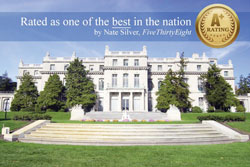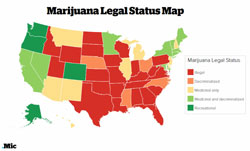The quality and accuracy of polls released by the Monmouth University Polling Institute has earned the University an A+ rating from Nate Silver’s widely respected news site, FiveThirtyEight.
The University ranked higher than many major media outlets and organizations such as Fox News, the Los Angeles Times, and Gallup, becoming one of only five polls to receive an A+ rating out of the 373 organizations reviewed by the site in August.
“This is a tremendous honor for everyone in our team at Monmouth,” said Patrick Murray, the director of the Polling Institute in an article by NJ.com. “We strive to be transparent in our methods so the public can be confident that their voice is being accurately reflected in all the work we do.”
According to President Paul Brown Ph.D., the A+ grade by FiveThirtyEight is calculated by analyzing the historical accuracy and methodology of our polls. He said, “This is really about the quality control and scientific approach utilized by Patrick Murray, the director of Monmouth University Polling Institute and his team. They have continued to make the Institute one of the nation’s best resources for accurate public opinion research.”
Ashley Medina, a graduate student and a research assistant who works at the Polling Institute has found the Institute, very beneficial to her success as a student. “In my opinion, the benefits of having the Polling Institute on campus are twofold. Locally, it lends students the opportunity to engage with the political process and to understand political communication in a more concrete and hands on way,” she said.
“It also offers opportunity to interested Monmouth students like myself who otherwise may not have the chance to work at such an acclaimed polling institution while in school. On a wider scale, the Polling Institute has helped to elevate Monmouth University’s name recognition nationwide which ultimately, increases the value of my degree,” Medina added.
According to Dr. Stephen Chapman, an Assistant Professor of Political Science and Sociology, collecting accurate data is no easy feat. He said, “The predictive power of MU polls is due to the stringent methodology employed behind the scenes by Patrick Murray, Tim Tracey, and other members of the staff. Accuracy has a lot to do with the sample size and how well that sample represents the larger population, how people are contacted, if the poll includes cell phones – a major factor for contacting younger portions of the population – among other factors.”
According to Dr. Joseph Patten, Associate Professor of Political Science and Sociology, the Institute puts a lot of work into selecting participants for their polls to be sure the demographics they sample are an accurate demonstration of the actual population of American voters. He explained that in order to create an accurate poll, polling groups must have an understanding of how to predict who will show up on election day.
He said, “There’s different groups in society and there are all of these models about who votes.”
Patten continued, “You have to look at these groups, these demographics, to try and understand what the final voting demographic will be, who is actually going to vote on election day. And you want to poll the same percentage of people who are going to vote.”
The sample of people to be polled must include a valid percentage of each demographic present in the voter population. Patten explained, “If you polled 70 percent of men, that would be a skewed poll if women are 54 percent of the turnout. You have to match up what you think the final turnout will be with different social groups and demographics, and have a roughly same percentage of that demographic in your poll. That’s called modeling – you have to model what the ultimate voting population will look like.”
The practice of modeling is just one of the many techniques students get to learn when they participate in the Polling Institute. “Our strategic plan emphasizes providing an intellectually challenging and rigorous academic experience. That’s really at the core of what we do. The Polling Institute provides a range of opportunities for students to engage in impactful social science research at the highest levels,” said Brown.
The skills students acquire from the Institute stick with them long after graduation. Chapman said, “I have had both undergraduate and graduate students who have worked with the Polling Institute. In those experiences, they have developed a range of tangible skills such as learning how to collect and analyze data, honing their writing prowess, and improving their interpersonal skills. These transformative experiences equip students with marketable skills and lasting memories well beyond their years at MU.”
The presence of the Institute on campus has proved to be beneficial to the entirety of the University community as well. President Brown said, “The Polling Institute has had such an extraordinarily positive effect on the University since it was established in 2005. Our name recognition and reputation has been enhanced significantly by the Polling Institute,” said Brown.
“I have heard from alumni all over the country, representing many different class years who have been thrilled so see Monmouth University mentioned so prominently in the national media,” Brown added.
“Monmouth University clearly gains a lot of attention because of the Institute. It’s difficult to watch any of the major news networks and not hear an MU poll mentioned. Aside from the obvious of offering MU additional publicity to attract new students, it is a positive for current MU students and the campus community at large,” Chapman added. “Current students have the opportunity to engage with one of the top polling institutes in the country; a feature even many elite research universities do not have. It also contributes to the culture of Monmouth as it instills a feeling of pride knowing that members of our campus community are contributing to democracy in action.”
Editor’s Note: Patrick Murray, the Director of the Polling Institute refused to comment for this story.
IMAGE TAKEN from monmouth.edu



